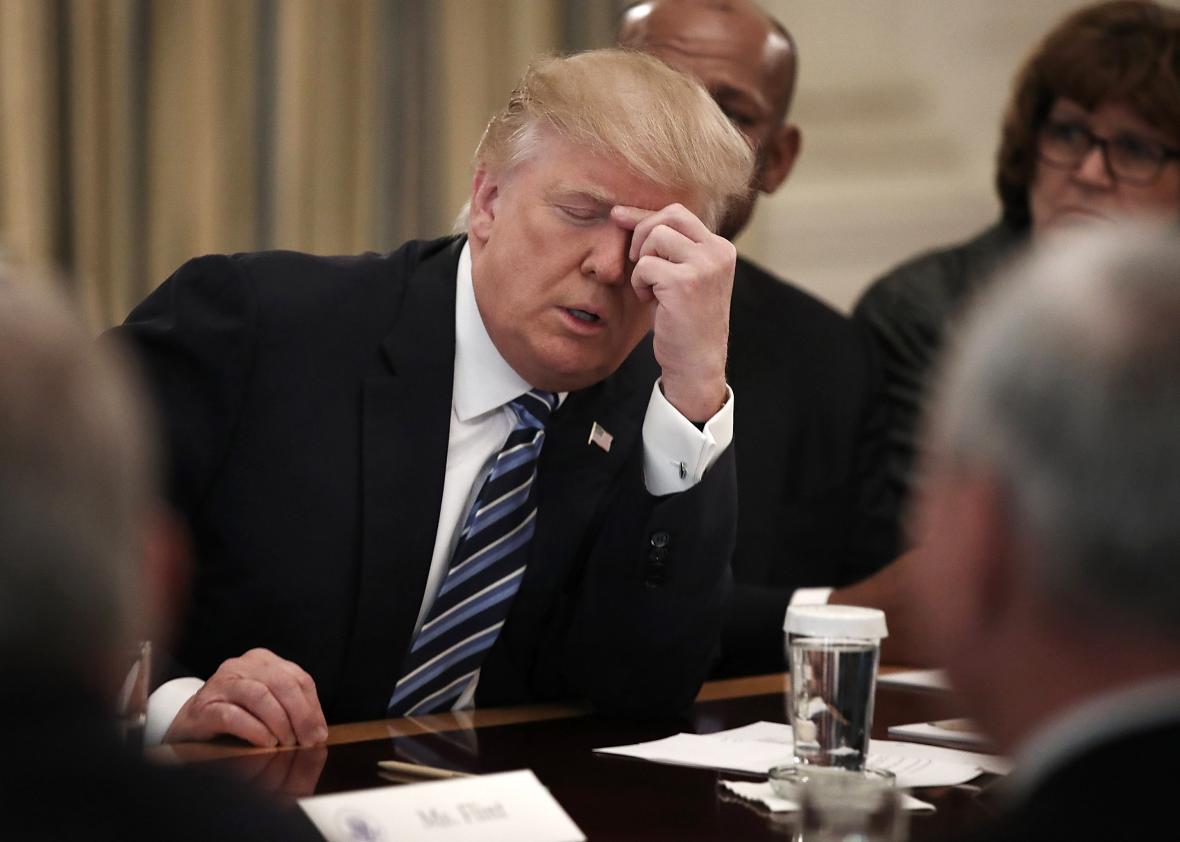Donald Trump signed an executive order on Monday that formally supplants the notorious travel ban he issued in January, which suspended the U.S. refugee program and temporarily barring entry of immigrants from seven Muslim-majority countries. This new ban appears to be reverse engineered from the appeals court decision blocking the old one; it remedies multiple legal infirmities and narrows the order’s scope. It is not clear, however, whether Monday’s order can fix a central flaw in the previous ban—the possibility that it was motivated by animus against Muslims. The threat of unconstitutional religious discrimination still lingers over this order, and will likely spur a new round of litigation.
One key problem with the old ban was its botched rollout: the administration infamously provided no grace period for those already in, or on their way to the United States. The new executive order attempts to rectify this issue by delaying its implementation: It will take effect on March 16, allowing those affected a (brief) period to change their plans. It does not affect lawful permanent residents—i.e., green card holders—or people who hold a valid visa when the new order takes effect, something that was unclear when the original ban was first announced. It also restores visas that were revoked “as a result of” the previous order. And it removes Iraq from the list of targeted countries.
Moreover, the new order expands the government’s ability to issue “case-by-case waivers” to immigrants affected by the ban. The old ban allowed these waivers only when they were “in the national interest” (a hazy standard, to say the least). Under the new order, Customs and Border Protection agents, as well as consular officers, may grant a waiver to immigrants from the six targeted countries if they fall under a number of categories. Those include foreign students stranded outside the United States on the day the order is signed; immigrants with “previously established significant contacts” with the U.S. who are outside the country when the order is signed; foreign nationals with “significant business or professional obligations” in the U.S.; foreign nationals “seeking to enter the United States to visit or reside with a close family member … who is a United States citizen, lawful permanent resident, or alien lawfully admitted on a valid nonimmigrant visa”; children and those in need of “urgent medical care,” or “someone whose entry is otherwise justified by the special circumstances of the case”; and immigrants who have previously served on behalf of the U.S. government (if they can prove their service).
These alterations seem to respond directly to the U.S. Court of Appeals for the 9th Circuit’s ruling that the original order likely violated due process by failing to provide “notice and a hearing prior to restricting an individual’s ability to travel.” Because the new ban incorporates a grace period, as well as additional procedural requirements and exemptions, it is much less susceptible to a due process challenge.
But what about the other legal attack on the original ban—the allegation that it discriminated against Muslims on the basis of their religion, in violation of the Establishment and Equal Protection clauses? That’s a much trickier question. The new order removes the most problematic language in the original ban, which explicitly prioritized the entry of refugees who faced “religious-based persecution” only if “the religion of the individual is a minority religion in the individual’s country of nationality.” This caveat made the order look a lot like the Muslim ban Trump promised throughout his campaign. In practice, it favored Christian refugees over Muslim refugees: A Christian and a Muslim might be equally persecuted on their basis of their religious beliefs, but because the Christian was “a minority religion,” he received preference over the Muslim.
With this troubling provision gone, a religious discrimination challenge to the order becomes more difficult, though not impossible. The Establishment Clause unambiguously prohibits government action that favors one religious denomination over another, while equal protection forbids invidious discrimination on the basis of religion. To prove that the new order contains impermissible religious discrimination, challengers will now have to rely on the fact that the ban still focuses on Muslim-majority countries—as well as Trump’s own statements on the campaign trail about a “Muslim ban.” Both the 9th Circuit and a federal judge in Virginia cited Trump’s comments with concern, and the Virginia judge made them a centerpiece of her ruling. Whether courts will impute unconstitutional motive to the new order remains an open question.
Monday’s order may be more legally sound than the previous travel ban, but that does not transmogrify it into good policy. The Trump administration still struggles to explain why it zeroed in on these particular countries; what specific threats they pose; why stemming the tide of refugees and immigrants will address these alleged threats; and why the ban must be so sweeping. It is still a breathtakingly cruel and dangerous order, one that will directly harm some of the most vulnerable people on the planet. It is, in short, a disaster. But whether it is a disaster that the judiciary can stop is a question that the courts must soon hash out.
